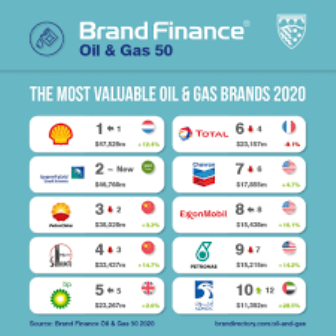
World’s most valuable and strongest Oil & Gas brands – report
World’s most valuable oil & gas brands suffer 16% brand value hit from COVID-19, amid oil price crash and rising wave of public pressure for sustainability
- Oil brands are solution, not problem; resources and expertise needed to facilitate energy transition and achieve net zero ambitions
- Shell remains world’s most valuable oil & gas brand, despite 11% dip in brand value to US$42.2 billion
- BP turning tide; regaining brand strength and reputation decade on from Deepwater Horizon incident
- ADNOC is most resilient NOC in terms of brand value, due to strategic direction and commitment of CEO H.E. Dr. Sultan Ahmed Al Jaber
- Oil & Gas’s first challenger brand, Neste, is highest ranked new entrant in 43rd spot
- PETRONAS is sector’s strongest, Brand Strength Index (BSI) score 87.0 out of 100
As oil & gas brands negotiate the fallout from the COVID-19 pandemic, the world’s top 50 most valuable oil & gas brands have lost 16% of brand value on average.
Oil & gas brands play a significant role in the global economy, both for fuelling lives today and determining the nature of energy in the future. For national oil companies (NOCs), economic contribution to national wealth is paramount to their mandate. To ensure this economic contribution is sustainable, NOCs must increasingly venture into new sources of energy for the world after oil.
Integrated international oil companies (IOCs), on the other hand, are guided by the will of their shareholders and by the threat of increased litigation. Particularly in Europe, the rise of ESG investing dictates that IOCs must act fast to retain and attract investors. Increasingly, both NOCs and IOCs are under pressure to reduce carbon footprints, boost sustainability, and move away from traditional oil.
Savio D’Souza, Valuation Director, Brand Finance, States:
Global dependence on oil is so ingrained that oil consumption only fell by 25% at the peak of COVID travel restrictions. Oil companies cannot simply hit the off switch; critical processes such as vaccine creation and distribution depend upon oil. But with rising global temperatures, humanity desperately needs a rapid, yet smooth transition to new energy forms. Oil companies are best placed to solve the problem, and to lead the transition to cleaner energy. Big oil brands have the expertise and resources to navigate the energy transition, and the Brand Finance Oil & Gas 50 ranking will reflect the brands which do so.
Oil & gas’s first challenger brand – Neste
Finnish brand Neste is the highest placed new entrant to the ranking in 43rd spot, with a brand value of US$2.2 billion. Neste is the world’s largest producer of renewable diesel and renewable jet fuel refined from waste and residues. Neste continues to challenge the status quo and is rolling out renewable solutions to the polymers and chemicals industries. Perhaps the first challenger brand to the oil & gas ranking, Neste has transformed from a national oil company to an integrated player, leading the path for circular solutions and innovation. Since “Neste Oil” became Neste in 2015, the company market cap has grown by over 800%, demonstrating the energy transition offers opportunity as well as challenge.
Oceans apart – US brands taking different approach to European peers
American oil & gas brands are taking a different view to their European peers about the pace of the energy transition. Like many NOCs, US energy companies project a solid future demand for oil, and therefore a long remaining lifespan of fossil fuel in the global economy. Under this perspective, executive management are focused on reducing costs and emissions per barrel produced.
Chevron’s low-carbon strategy remains focused on reducing emissions from operations, including by linking renewables to its operations, and investing further in carbon capture and storage – the brand recently announcing investment into carbon capture storage expert, Blue Planet Systems. In downstream, Chevron is leveraging its strong brand to expand its petrochemicals, lubricants, and additives business.
Chevron’s brand value fell by 11% this year to US$15.9 billion, compared to an average fall of 22% for US oil brands in the ranking. Production cuts induced by the oil price plunge meant that April 2020 saw the biggest one-month production cut since the Great Recession.
In 2015 when the Brand Finance Oil & Gas 50 ranking was first released, US brands represented 32% of the ranking’s total brand value, with 21 brands featuring in the top 50. Today, the US accounts for just 22% of total brand value, with 15 brands represented in the top 50.
Texas and Oklahoma-based hydrocarbon exploration brands are among those which no longer rank. As Joe Biden is expected to signal US intentions to re-join the Paris climate accord, the green agenda may become more prevalent for US oil brands in coming years. Brands which fail to adapt – by diversifying into new solutions or by expanding carbon capture – will increasingly be subject to operational, legal, and reputational risk to their brand and business value.
Information Source: Read Full Release .. Buy Report–>
Press release Submitted by:

Every year, Brand Finance puts 5,000 of the biggest brands to the test, evaluating their strength and quantifying their value, and publishes nearly 100 reports, ranking brands across. all sectors and countries. The world’s 50 most valuable oil & gas brands are included in the Brand Finance Oil & Gas 50 2021 report.


